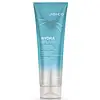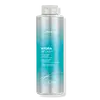What's inside
What's inside
 Benefits
Benefits

 Concerns
Concerns

 Ingredients Side-by-side
Ingredients Side-by-side

Water
Skin ConditioningCetearyl Alcohol
EmollientBehentrimonium Chloride
PreservativeIsopropyl Palmitate
EmollientStearyl Alcohol
EmollientPropylene Glycol
HumectantPhenoxyethanol
PreservativeEthylhexyl Olivate
Skin ConditioningCocos Nucifera Oil
MaskingHelianthus Annuus Seed Oil
EmollientRosa Canina Fruit Oil
EmollientLaurdimonium Hydroxypropyl Hydrolyzed Keratin
Skin ConditioningPhosphatidylcholine
EmulsifyingArginine Hcl
Skin ConditioningHydrolyzed Algin
Sea Water
HumectantChlorella Vulgaris Extract
Skin ConditioningDipropylene Glycol
HumectantCetyl Esters
EmollientHydroxyethylcellulose
Emulsion StabilisingBisamino PEG/PPG-41/3 Aminoethyl Pg-Propyl Dimethicone
Carthamus Tinctorius Seed Oil
MaskingGuar Hydroxypropyltrimonium Chloride
Skin ConditioningPolyquaternium-37
Isostearyl Ethylimidazolinium Ethosulfate
Tetrasodium Glutamate Diacetate
Propylene Glycol Dicaprylate/Dicaprate
EmollientPEG-4 Laurate
EmulsifyingPEG-14m
Emulsion StabilisingStyrene/Butadiene Copolymer
Squalane
EmollientCitric Acid
BufferingPPG-1 Trideceth-6
Skin ConditioningIsopropyl Alcohol
SolventSodium Hydroxide
BufferingIodopropynyl Butylcarbamate
PreservativeSodium Benzoate
MaskingPotassium Sorbate
PreservativeLinalool
PerfumingLimonene
PerfumingParfum
MaskingCI 42090
Cosmetic ColorantCI 60730
Cosmetic ColorantCI 19140
Cosmetic ColorantWater, Cetearyl Alcohol, Behentrimonium Chloride, Isopropyl Palmitate, Stearyl Alcohol, Propylene Glycol, Phenoxyethanol, Ethylhexyl Olivate, Cocos Nucifera Oil, Helianthus Annuus Seed Oil, Rosa Canina Fruit Oil, Laurdimonium Hydroxypropyl Hydrolyzed Keratin, Phosphatidylcholine, Arginine Hcl, Hydrolyzed Algin, Sea Water, Chlorella Vulgaris Extract, Dipropylene Glycol, Cetyl Esters, Hydroxyethylcellulose, Bisamino PEG/PPG-41/3 Aminoethyl Pg-Propyl Dimethicone, Carthamus Tinctorius Seed Oil, Guar Hydroxypropyltrimonium Chloride, Polyquaternium-37, Isostearyl Ethylimidazolinium Ethosulfate, Tetrasodium Glutamate Diacetate, Propylene Glycol Dicaprylate/Dicaprate, PEG-4 Laurate, PEG-14m, Styrene/Butadiene Copolymer, Squalane, Citric Acid, PPG-1 Trideceth-6, Isopropyl Alcohol, Sodium Hydroxide, Iodopropynyl Butylcarbamate, Sodium Benzoate, Potassium Sorbate, Linalool, Limonene, Parfum, CI 42090, CI 60730, CI 19140
Water
Skin ConditioningSodium Laureth Sulfate
CleansingCocamide Mipa
EmulsifyingDisodium Cocoamphodiacetate
CleansingGlycol Stearate
EmollientSodium Chloride
MaskingButyrospermum Parkii Butter
Skin ConditioningLaurdimonium Hydroxypropyl Hydrolyzed Keratin
Skin ConditioningArginine Hcl
Skin ConditioningPhosphatidylcholine
EmulsifyingRosa Canina Fruit Oil
EmollientCocos Nucifera Oil
MaskingHydrolyzed Algin
Sea Water
HumectantChlorella Vulgaris Extract
Skin ConditioningSodium Cetearyl Sulfate
CleansingCocamidopropyl Betaine
CleansingGuar Hydroxypropyltrimonium Chloride
Skin ConditioningCetyl Alcohol
EmollientAcrylates/Aminoacrylates/C10-30 Alkyl PEG-20 Itaconate Copolymer
Emulsion StabilisingDimethicone
EmollientSodium Citrate
BufferingCitric Acid
BufferingPEG-4 Laurate
EmulsifyingDisodium EDTA
Polyquaternium-7
DMDM Hydantoin
PreservativeIodopropynyl Butylcarbamate
PreservativeSodium Benzoate
MaskingMethylchloroisothiazolinone
PreservativeMethylisothiazolinone
PreservativePhenoxyethanol
PreservativePotassium Sorbate
PreservativeLinalool
PerfumingLimonene
PerfumingParfum
MaskingCI 42090
Cosmetic ColorantCI 60730
Cosmetic ColorantCI 19140
Cosmetic ColorantWater, Sodium Laureth Sulfate, Cocamide Mipa, Disodium Cocoamphodiacetate, Glycol Stearate, Sodium Chloride, Butyrospermum Parkii Butter, Laurdimonium Hydroxypropyl Hydrolyzed Keratin, Arginine Hcl, Phosphatidylcholine, Rosa Canina Fruit Oil, Cocos Nucifera Oil, Hydrolyzed Algin, Sea Water, Chlorella Vulgaris Extract, Sodium Cetearyl Sulfate, Cocamidopropyl Betaine, Guar Hydroxypropyltrimonium Chloride, Cetyl Alcohol, Acrylates/Aminoacrylates/C10-30 Alkyl PEG-20 Itaconate Copolymer, Dimethicone, Sodium Citrate, Citric Acid, PEG-4 Laurate, Disodium EDTA, Polyquaternium-7, DMDM Hydantoin, Iodopropynyl Butylcarbamate, Sodium Benzoate, Methylchloroisothiazolinone, Methylisothiazolinone, Phenoxyethanol, Potassium Sorbate, Linalool, Limonene, Parfum, CI 42090, CI 60730, CI 19140
Ingredients Explained
These ingredients are found in both products.
Ingredients higher up in an ingredient list are typically present in a larger amount.
We don't have a description for Arginine Hcl yet.
Chlorella Vulgaris Extract comes from a green microalga. It is hydrating and contains antioxidants.
Studies also show Chlorella Vulgaris may help in rebuilding collagen and elastin. This ingredient is made up of lipids, carbohydrates, and chlorophyll.
Fun fact: This ingredient is commonly used as food additive in Japan.
Learn more about Chlorella Vulgaris ExtractCI 19140 is also known as Tartrazine. Tartrazine is a synthetic dye used in cosmetics, foods, and medicine to add a yellow color.
Tartrazine is created from petroleum and is water-soluble.
Some people may experience allergies from this dye, especially asthmatics and those with an aspirin intolerance.
Learn more about CI 19140Ci 42090 is a synthetic dye created from petroleum. It is used to give a bright blue color to cosmetics, medicine, and food.
This ingredient is a purple dye. It is also known as Violet No. 2 or Acid Violet 43 and is a synthetic dye derived from coal tar.
According to a manufacturer, this dye it known for its intense color saturation and resistance to fading.
Citric Acid is an alpha hydroxy acid (AHA) naturally found in citrus fruits like oranges, lemons, and limes.
Like other AHAs, citric acid can exfoliate skin by breaking down the bonds that hold dead skin cells together. This helps reveal smoother and brighter skin underneath.
However, this exfoliating effect only happens at high concentrations (20%) which can be hard to find in cosmetic products.
Due to this, citric acid is usually included in small amounts as a pH adjuster. This helps keep products slightly more acidic and compatible with skin's natural pH.
In skincare formulas, citric acid can:
While it can provide some skin benefits, research shows lactic acid and glycolic acid are generally more effective and less irritating exfoliants.
Most citric acid used in skincare today is made by fermenting sugars (usually from molasses). This synthetic version is identical to the natural citrus form but easier to stabilize and use in formulations.
Read more about some other popular AHA's here:
Learn more about Citric AcidCocos Nucifera Oil is obtained from the kernels of the coconut fruit. In other words, this is coconut oil.
Coconut Oil is rich in fatty acids with lauric acid making up the majority of these. It also contains linoleic acid. Due to this high fatty acid content, coconut oil helps trap moisture and soften skin.
Despite being antibacterial, coconut oil may not be great for acne-prone skin. It is comedogenic and may clog pores. This ingredient may not be safe for malassezia or fungal acne.
Note: Coconut Oil should not replace your sunscreen for UV protection. Studies show it only blocks about 20% of UV.
This oil is non-volatile and has a light scent.
The term 'fragrance' is not regulated in many countries. In many cases, it is up to the brand to define this term. For instance, many brands choose to label themselves as "fragrance-free" because they are not using synthetic fragrances. However, their products may still contain ingredients such as essential oils that are considered a fragrance.
Learn more about Cocos Nucifera OilThis ingredient is derived from guar gum.
It is a conditioning ingredient, meaning it helps soften skin and hair.
We don't have a description for Hydrolyzed Algin yet.
Iodopropynyl Butylcarbamate is a preservative.
We don't have a description for Laurdimonium Hydroxypropyl Hydrolyzed Keratin yet.
Limonene is a fragrance that adds scent and taste to a formulation.
It's found in the peel oil of citrus fruits and other plants such as lavender and eucalyptus. The scent of limonene is generally described as "sweet citrus".
Limonene acts as an antioxidant, meaning it helps neutralize free radicals.
When exposed to air, oxidized limonene may sensitize the skin. Because of this, limonene is often avoided by people with sensitive skin.
The term 'fragrance' is not regulated in many countries. In many cases, it is up to the brand to define this term. For instance, many brands choose to label themselves as "fragrance-free" because they are not using synthetic fragrances. However, their products may still contain ingredients such as essential oils that are considered a fragrance.
Learn more about LimoneneLinalool is a fragrance and helps add scent to products. It's derived from common plants such as cinnamon, mint, citrus, and lavender.
Like Limonene, this ingredient oxidizes when exposed to air. Oxidized linalool can cause allergies and skin sensitivity.
This ingredient has a scent that is floral, spicy tropical, and citrus-like.
Learn more about LinaloolParfum is a catch-all term for an ingredient or more that is used to give a scent to products.
Also called "fragrance", this ingredient can be a blend of hundreds of chemicals or plant oils. This means every product with "fragrance" or "parfum" in the ingredients list is a different mixture.
For instance, Habanolide is a proprietary trade name for a specific aroma chemical. When used as a fragrance ingredient in cosmetics, most aroma chemicals fall under the broad labeling category of “FRAGRANCE” or “PARFUM” according to EU and US regulations.
The term 'parfum' or 'fragrance' is not regulated in many countries. In many cases, it is up to the brand to define this term.
For instance, many brands choose to label themselves as "fragrance-free" because they are not using synthetic fragrances. However, their products may still contain ingredients such as essential oils that are considered a fragrance by INCI standards.
One example is Calendula flower extract. Calendula is an essential oil that still imparts a scent or 'fragrance'.
Depending on the blend, the ingredients in the mixture can cause allergies and sensitivities on the skin. Some ingredients that are known EU allergens include linalool and citronellol.
Parfum can also be used to mask or cover an unpleasant scent.
The bottom line is: not all fragrances/parfum/ingredients are created equally. If you are worried about fragrances, we recommend taking a closer look at an ingredient. And of course, we always recommend speaking with a professional.
Learn more about ParfumPEG-4 Laurate isn't fungal acne safe.
Phenoxyethanol is a preservative that has germicide, antimicrobial, and aromatic properties. Studies show that phenoxyethanol can prevent microbial growth. By itself, it has a scent that is similar to that of a rose.
It's often used in formulations along with Caprylyl Glycol to preserve the shelf life of products.
Phosphatidylcholine is a type of phospholipid. Phospholipids are naturally found in our skin as they are the main component of cell membranes. Phospholipids are skin-replenishing.
This ingredient can be found in the Lecithin of soybeans.
Potassium Sorbate is a preservative used to prevent yeast and mold in products. It is commonly found in both cosmetic and food products.
This ingredient comes from potassium salt derived from sorbic acid. Sorbic acid is a natural antibiotic and effective against fungus.
Both potassium sorbate and sorbic acid can be found in baked goods, cheeses, dried meats, dried fruit, ice cream, pickles, wine, yogurt, and more.
You'll often find this ingredient used with other preservatives.
Learn more about Potassium SorbateRosehip Oil is a non-fragrant plant oil. Rosehips are a fruit from a rose bush and are edible. This oil has skin conditioning and hydrating properties.
Rosehip contains Vitamin C, Vitamin E, fatty acids and linolenic acids. These nourish your skin barrier. Having hydrated skin may help reduce the appearance of fine-lines and wrinkles.
Another great component of Rosehip Oil is Vitamin A, or retinol. Vitamin A encourages your skin to create more collagen.
Rosehip oil may help with reducing pigmentation. The lycopene and beta-carotene have skin-lightening properties. However, more studies are needed to confirm this.
Learn more about Rosa Canina Fruit OilSodium Benzoate is a preservative. It's used in both cosmetic and food products to inhibit the growth of mold and bacteria. It is typically produced synthetically.
Both the US FDA and EU Health Committee have approved the use of sodium benzoate. In the US, levels of 0.1% (of the total product) are allowed.
Sodium benzoate works as a preservative by inhibiting the growth of bacteria inside of cells. It prevents the cell from fermenting a type of sugar using an enzyme called phosphofructokinase.
It is the salt of benzoic acid. Foods containing sodium benzoate include soda, salad dressings, condiments, fruit juices, wines, and snack foods.
Studies for using ascorbic acid and sodium benzoate in cosmetics are lacking, especially in skincare routines with multiple steps.
We always recommend speaking with a professional, such as a dermatologist, if you have any concerns.
Learn more about Sodium BenzoateWater. It's the most common cosmetic ingredient of all. You'll usually see it at the top of ingredient lists, meaning that it makes up the largest part of the product.
So why is it so popular? Water most often acts as a solvent - this means that it helps dissolve other ingredients into the formulation.
You'll also recognize water as that liquid we all need to stay alive. If you see this, drink a glass of water. Stay hydrated!
Learn more about Water